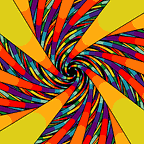IPv6- How does a host get a global unicast with EUI-64 method?
The IPv6 global unicast address is similar to IPv4 public IP address. It is used when a host wants to use the internet.
2001:1234:ABCD:5678:0221:2FFF:FEB5:6E10
This example address shows 8 groups of 16-bit hexadecimal numbers, separated by colons, 128 bit long altogether. Starting with 2001, a global unicast address consists of 3 sections. 2001:1234:ABCD is called a global routing prefix (first 48 bits). 5678 is called the subnet ID (next 16 bits). The third part, 0221:2FFF:FEB5:6E10 is called the interface ID (last 64 bits), which is the host part.
Obtaining the address
This is a 2-step process. The global routing prefix and the subnet ID come from the default gateway. The interface ID is generated by the host device.
The first 64 bits:
An IPv6 global unicast address is generally assigned in a hierarchical manner. Internet Assigned Numbers Authority (IANA) is responsible for DNS root, IP addressing assigns the first 16 bits (2001). At the second level, the regional ISP adds another 16 bits (1234). At the third level, the ISP adds another 16-bits (ABCD). At the fourth level, the default gateway of any organization adds another 16-bits (5678).
The last 64 bits:
The interface ID is derived from the device’s MAC address. The MAC address is 48 bits long. The first 24 bits are called the OUI (Organizationally Unique Identifier) which identifies the manufacturer. The second 24 bits correspond to the NIC (Network Interface Controller).
Ex — 00-AC-08–23-B5–78
The host generates this ID using a technique called EUI-64 (Extended Unique Identifier) which allows a host to self-assign with a unique 64-bit IPv6 Interface ID.
A MAC address is only 48 bits long. The second part of the address is generated using the MAC address and a feature called EUI-64 which stands for Extended Unique Identifier. It allows the device to generate a 64-bit IPv6 interface ID. This is a plus point of IPv6 over IPv4 as the host is more in control and eliminates the need for a manual configuration of the DHCP server is needed.
The MAC address is split in half and a16 bit extra hex number is put in the middle of both.
Now, the 7th bit from the left is split. The first 2 0s in this example when converted to binary result in 00000000. After splitting the 7th bit it becomes 00000010.
